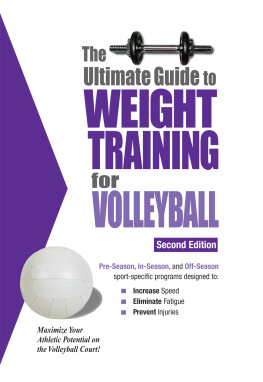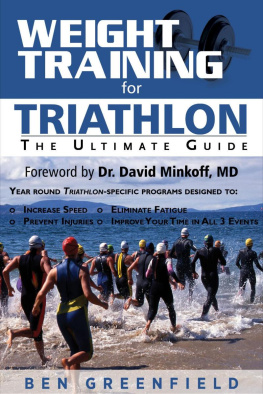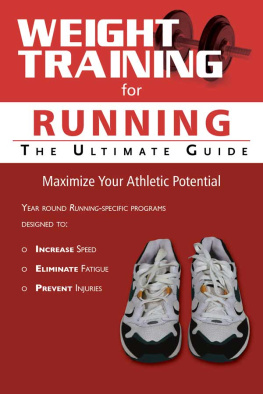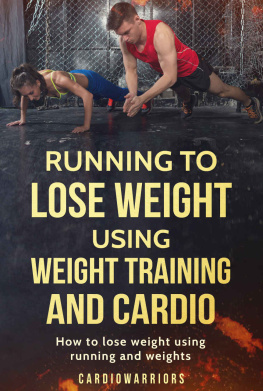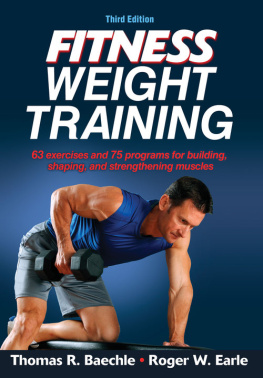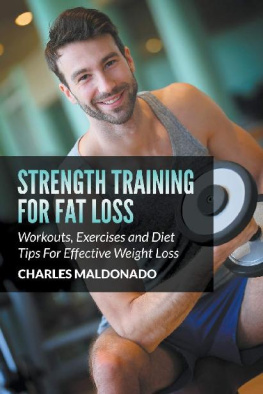Alan John - Weight Lifting and Weight Training: A Scientifically Founded Beginners Guide to Better Your Health Through Weight Training
Here you can read online Alan John - Weight Lifting and Weight Training: A Scientifically Founded Beginners Guide to Better Your Health Through Weight Training full text of the book (entire story) in english for free. Download pdf and epub, get meaning, cover and reviews about this ebook. year: 2020, publisher: Jonathan Law, genre: Romance novel. Description of the work, (preface) as well as reviews are available. Best literature library LitArk.com created for fans of good reading and offers a wide selection of genres:
Romance novel
Science fiction
Adventure
Detective
Science
History
Home and family
Prose
Art
Politics
Computer
Non-fiction
Religion
Business
Children
Humor
Choose a favorite category and find really read worthwhile books. Enjoy immersion in the world of imagination, feel the emotions of the characters or learn something new for yourself, make an fascinating discovery.

- Book:Weight Lifting and Weight Training: A Scientifically Founded Beginners Guide to Better Your Health Through Weight Training
- Author:
- Publisher:Jonathan Law
- Genre:
- Year:2020
- Rating:4 / 5
- Favourites:Add to favourites
- Your mark:
- 80
- 1
- 2
- 3
- 4
- 5
Weight Lifting and Weight Training: A Scientifically Founded Beginners Guide to Better Your Health Through Weight Training: summary, description and annotation
We offer to read an annotation, description, summary or preface (depends on what the author of the book "Weight Lifting and Weight Training: A Scientifically Founded Beginners Guide to Better Your Health Through Weight Training" wrote himself). If you haven't found the necessary information about the book — write in the comments, we will try to find it.
Alan John: author's other books
Who wrote Weight Lifting and Weight Training: A Scientifically Founded Beginners Guide to Better Your Health Through Weight Training? Find out the surname, the name of the author of the book and a list of all author's works by series.
Weight Lifting and Weight Training: A Scientifically Founded Beginners Guide to Better Your Health Through Weight Training — read online for free the complete book (whole text) full work
Below is the text of the book, divided by pages. System saving the place of the last page read, allows you to conveniently read the book "Weight Lifting and Weight Training: A Scientifically Founded Beginners Guide to Better Your Health Through Weight Training" online for free, without having to search again every time where you left off. Put a bookmark, and you can go to the page where you finished reading at any time.
Font size:
Interval:
Bookmark:
Weight Lifting and Weight Training
A Scientifically Founded Guide to Increasing Your Health Through Weigh tlifting
For legal purposes, Alan John cannot guarantee the success of the expressions and suggestions of the content, as well as guarantee its accuracy. In addition, to the extent permitted by the law, Alan John shall not be responsible for any losses and/ or damage due to the usage of the information in this book, eBook, or any reproduction in any form. All images original property of the author or copyright-free as stated by image sources. Names Of companies and people do not necessarily reflect real-life names or titles. By reading beyond this page and putting into action anything recommended in this book, you hereby consent to this disclaimer and agree to its terms.
This information is not presented by a medical practitioner and is for educational and informational purposes only. The content is not intended to be a substitute for professional medical advice, diagnosis, or treatment. Always seek the advice of your physician or other qualified health care provider with any questions you may have regarding a medical condition. Never disregard professional medical advice or delay in seeking it because of something you have read or heard.
Copyright 2020 by Alan W. John
All rights reserved. This Book or parts thereof may not be reproduced in any form, stored in any retrieval system, or transmitted in any form by any means electronic, mechanical, photocopy, recording, or otherwise without prior written permission of the publisher, except for the use of brief quotations under the United States copyright law. For permission requests, contact
Alan John, 2020
Table Of Contents:
Whether you call it weightlifting, pumping iron, or bodybuildin g, lifting weight , both light and heavy ,has long been the method to get in shape and stay in shape. Weightlifting, or weight training , has many health benefits for both men and wom en. We ightlifting routines exist which are appropriate for men, women , and even children of any age, any size, and any body type. If you want to build muscle mass, increase stamina, improve cardiac function, even stave off the symptoms of osteoporosis - you can accomplish all of that and so much more by adding a good weight training routine to your regular workou t. To get the most health benefit out of lifting weights, you need to combine your weight training with other exercises . If you are not already doing some kind of aerobic or cardio workout everyday, you must do this in addition to weight lifting. It is not healthy to just begin to lift weights without a proper warm up. Of course before starting any workout routine, check with your doctor. Prior to starting your weight lifting workout you need to "get the blood moving" and your muscles primed for some heavy lifting. Just before hitting the weights do a good ten minutes on a bicycle, take a short jog, or jump rope. Do a few legs and arm stretches as well. The key to successful weight training involves what are called repetitions. In lifting it is not so important how much you lift, but how many times you can lift the weight. A proper weight lifting routine will be designed to work out all of the major muscle groups of the body, which include: The Shoulders, Neck and Back, Biceps, Triceps, Quadriceps Chest, Abs, Hamstrings, Calves, and of course the Gluteus.
The next question on your mind is likely to be "should I use free weights or machines?" and "how much weight should I work out with?" You can use free weights or machines or maybe a little of both. If you are working out in a gym, of course they will have both and will likely be able to recommend a "circuit" of weight lifting exercises for you. If you intend to lift weights in the home, it all depends on your budget and physical space to determine if you want to buy a "Home Gym" type resistance trainer such as Bowflex - or a good set of free weights and barbells - or both. Weight machines are great for beginners because they have been designed to work a specific muscle or muscle group, and will ensure that you are seated or standing in the right position to target that group when you lift. Free weights are the traditional barbells and dumbbells that have been around for centuries, and they work great. In fact some would argue that once you learn how to use them properly you get a better workout than machines because it is only the force of your muscles and your ability to balance the weight that keeps the weight and your muscles moving properly. There is no aid from the machine, so you are effectively using more muscle with free weights.
Lifting weights improves your strength and stamina. Lifting weights builds muscle and confidence, improves cardiovascular health and can actually help prevent other sports injuries. And lifting weights can help you lose extra pounds and keep them off - so what are you "weighting" for? Come on, and get pumping!
We all know that lifting weights leads to bigger muscles, harder muscles, and more definition. But just how does weight lifting do that? What is the physiology of weight lifting?
Basically weight lifting is a method of strength training. Lifting weights uses the force of gravity to oppose muscle contraction. Overcoming that opposition increases strength and builds muscle. The concept was simply and elegantly summed up by Hippocrates centuries ago That which is used develops, and that which is unused wastes away. He was correct and his contemporaries while not sure of the anatomical science behind it, also understood the basic weight lifting and strength
training concept of progressive resistance. It has been said that ancient Greek wrestler s, when training for the early Olympic Games, carried a newborn calf on their back everyday until it was grown. While that may not go over very well at your gym, the concept is sound. Weight lifting builds strength and muscle mass through progressive resistance. The reasons our muscles grow and become stronger when we workout with weights is due to the body's response to injury. Muscle growth from weight lifting is basically a healing process. When we lift weights, we do (when done correctly) a small amount of microtrauma to our muscle tissue. The bodys response to the trauma is to rebuild the weakened or torn muscle fibers, and in doing so build them even bigger and stronger then they were prior to the microtrauma so as to prevent repeat of the injury. So that is how progressive resistance works in weight lifting and weight training. We add more weight, do more reps, and tear down more muscle fiber - the body keeps responding by healing the muscle eventually pushing the muscle to its ultimate limit, which is genetically determined.
Professional powerlifters , other athletes, and experienced weightlifters will use this concept when training or working with weights by adding weight to the point they cannot lift and then backing off just a bit and then push the maximum weight possible. This is called progressive overload and it forces the muscles to grow stronger and larger to lift the heavier weight. However working out by lifting weights at the ultimate limit of your strength is not recommended for novice weightlifters . Professionals say beginners can achieve the same results a lot safer, by progressively adding repetitions to the workout, and not lifting heavier weights. This will still fatigue muscles, wear down fibers, and result in the progressive microtrauma required to build muscle, strength and stamina.
So what does all this mean? In order for weight lifting to result in building muscle and increasing strength, you must allow the body some down time to heal. Because it is this healing that is really the process of building renewed and strengthened muscle tissue. What that means is that you should not lift everyday especially in the beginning of your weight lifting regimen. Muscle growth can take anywhere from 2 to 4 days. So beginners generally will workout out every other day. The more experienced you are the longer the recovery period actually can be. Professional or very experienced weight lifters require more strength to push the limit, and cause more damage when they do, and therefore require longer time to build and repair muscles to greater strength. The pros will use a weight lifting routine that works any given specific muscle group only every 4 days.
Next pageFont size:
Interval:
Bookmark:
Similar books «Weight Lifting and Weight Training: A Scientifically Founded Beginners Guide to Better Your Health Through Weight Training»
Look at similar books to Weight Lifting and Weight Training: A Scientifically Founded Beginners Guide to Better Your Health Through Weight Training. We have selected literature similar in name and meaning in the hope of providing readers with more options to find new, interesting, not yet read works.
Discussion, reviews of the book Weight Lifting and Weight Training: A Scientifically Founded Beginners Guide to Better Your Health Through Weight Training and just readers' own opinions. Leave your comments, write what you think about the work, its meaning or the main characters. Specify what exactly you liked and what you didn't like, and why you think so.


